This is a free fortnightly newsletter about the New Zealand Net. If you would like to be notified by email when a new edition is published, please contact ZL1NZ.
Browse our Newsletter Archive and List of Net Tips.
Featured key
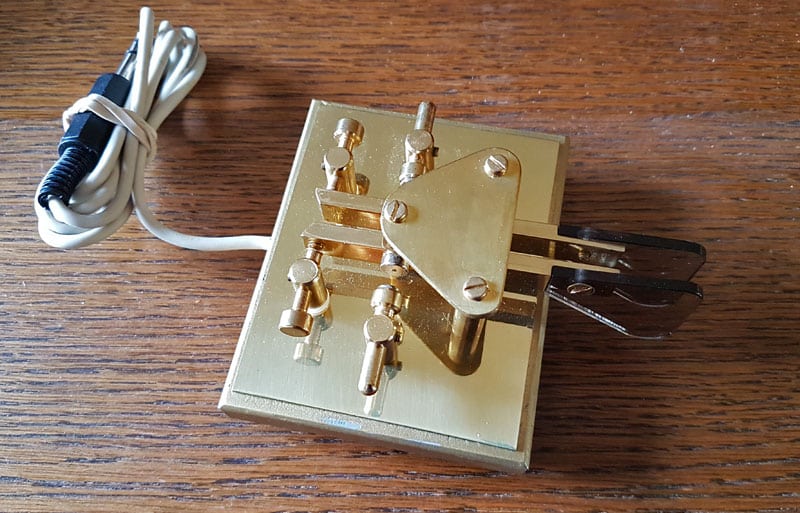
TW MagPad dual-lever paddles. Photo: SM5LNE
The TW MagPad is a dual-lever paddle using magnetic return, and built of brass components on a brass plate which sits on a painted steel base. The screws have very fine adjustments and the finger pieces are laser cut. The key weighs 1 kilogram.
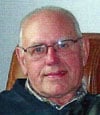 The MagPag was designed by Tom Withers G3HGE (pictured), a CW operator for over 60 years and the driving force behind TW Electronics Ltd which made VHF amateur radio gear. The business closed in 2000, when mass-produced Japanese radio equipment arrived on the scene, but a decade later Tom began making and selling Morse keys, including a bug, a sideswiper and the eZKe, a single-lever paddle similar in appearance to the MagPad. Tom became a Silent Key in 2019.
The MagPag was designed by Tom Withers G3HGE (pictured), a CW operator for over 60 years and the driving force behind TW Electronics Ltd which made VHF amateur radio gear. The business closed in 2000, when mass-produced Japanese radio equipment arrived on the scene, but a decade later Tom began making and selling Morse keys, including a bug, a sideswiper and the eZKe, a single-lever paddle similar in appearance to the MagPad. Tom became a Silent Key in 2019.
About 104 MagPads were built, and the photo above shows number 017, in the collection of NZ Net News reader Jan SM5LNE.
See below for a video about the TW MagPad.
* If you have an interesting key for this feature, please send me a nice clear photo and a few words describing it.
Quick notes

Kimberly ZL4KJ has been absent from NZ Net for awhile. Her antenna was taken down by a tree on 20 May. Due to increased workload, plus family commitments, she is unlikely to be back on the air for awhile, and possibly not until after she and her family move from Palmerston North to Invercargill.
I was watching an online video about HF antennas, and the presenter explained that since one particular antenna had fairly narrow bandwidth, you would cut it either for the fone band or for FT8. Now I am really depressed!
Radio Relay International has a new website (still under construction) and a new address: radiorelay.org
Any ZC1 owners reading this? I have a little booklet titled New Zealand Wireless Sets & Stations No. ZC.1 MK.II. Combined Provision and Maintenance Schedules (essentially a parts list). It is in very good, unmarked condition. No publication date, but looks to have been contemporary with the ZC1 production years. I would be happy to give it to a ham with an interest in these WW2 radios. Please contact me, or pass this info to others who might be interested.
Photo flashback
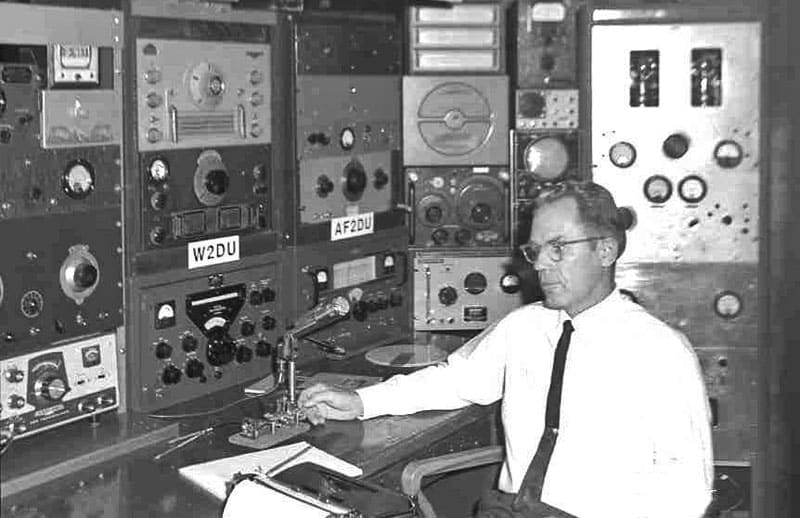
Here’s a fine looking setup for CW traffic handling. The operator is Walt Maxwell W2DU, well known for his technical articles in QST and for the W2DU Balun. In this 1968 photo Walt has a modern HW-100 transceiver, along with some nice boat anchors, including a Collins 75A-2 or 75A-3 and a Collins 32V-3 CW/AM transmitter. Walt became a silent key ten years ago.
Who Am I?
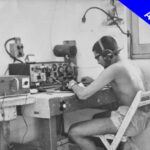 The photo in NZ Net News 84 was taken in 1963, at a lighthouse in the Western Sahara. As our mystery operator explains:
The photo in NZ Net News 84 was taken in 1963, at a lighthouse in the Western Sahara. As our mystery operator explains:
“When I was on the Canary Island of Gran Canaria doing my Military Service, a place became available for a voluntary radiotelegraphist on a six-month posting to the (then) Spanish Sahara. I put my hand up – and soon I found myself living at Cape Bojador Lighthouse.
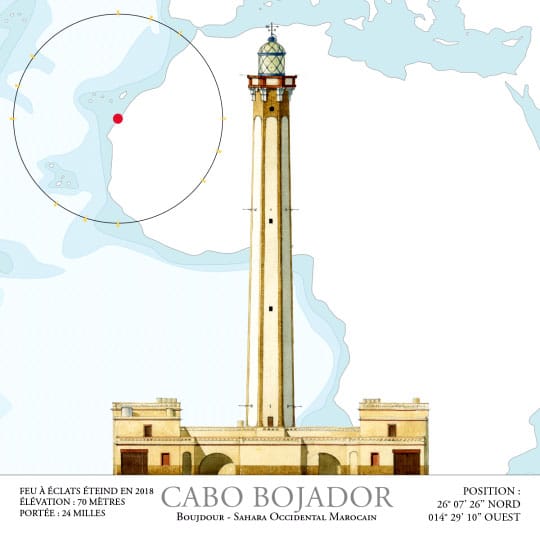 “It was a very simple radio station. The rig was a WW2-era WS-19 transmitter/receiver. We used to have trouble keeping the battery charged, so I suggested installing a wind generator. It took a couple of months to arrive, together with a few bags of concrete for the foundations. By the time I had finished pouring the concrete, it was time for me to leave!
“It was a very simple radio station. The rig was a WW2-era WS-19 transmitter/receiver. We used to have trouble keeping the battery charged, so I suggested installing a wind generator. It took a couple of months to arrive, together with a few bags of concrete for the foundations. By the time I had finished pouring the concrete, it was time for me to leave!
“My duties included collecting data three times a day from meteorological instruments, recording it, and sending it as a radiogram in CW to the base on Gran Canaria. Also, if an aircraft flew over us, I would have to call them (on voice).
“I cannot remember exactly how many people were there but I think there were about six mechanical engineers to look after the lighthouse equipment, a store keeper, a cook/baker and about twenty military personnel including a doctor, one radiotelegraphist from the Army and myself from the Navy.
“It was lovely warm weather, no need for a coat, gloves or beanie. The only problem was when the sand storms came and blocked our doors. We had to use shovels to clear the path.”
ZL1RA managed to correctly identify our mystery operator as Manny VK3DRQ, after reading Manny’s story about the 1966 sinking of Monte Palomares.
The Who Am I? feature will resume if I receive more historical photos of NZ Net operators.
Morse musings: Avoid crutches for CW
By Mike ZL1RA
The purpose of this article is to hopefully offer some advice and encouragement to any new ham who is considering operating CW on the air, from the firsthand exposure of a newbie. I gained my licence in April 2021 and have been on the air for 15 months, but only 11 months on CW.
The NZ Association of Radio Transmitters (NZART) recommends learning Morse code with either Teach Morse or LCWO.net.
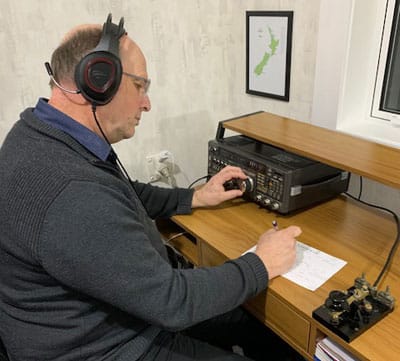 Whichever method you opt for, I have found it to be imperative that you set the character speed at 20 words per minute right from the start, so you only ever hear the characters as sound patterns.
Whichever method you opt for, I have found it to be imperative that you set the character speed at 20 words per minute right from the start, so you only ever hear the characters as sound patterns.
Once all characters, numbers, punctuation and prosigns have been learnt to 90% and above accuracy, it is time to go on the air, right?
Wrong! Now is the time to conscientiously practice LISTENING.
Listen to on-air QSOs and rag-chews until you are confident that what you are hearing, with your ears only, is making sense to you and you are comfortably sitting back and enjoying listening to the Morse code coming from your radio.
Learning from mistakes
In my enthusiasm to be a CW operator, the first mistake I made was to jump on the air too soon. While I could send good code at 20 words per minute, I couldn’t receive anywhere near as fast as that. During my first few contacts I was getting the other operators’ callsigns wrong and having to ask for repeats. While most CW operators don’t mind slowing down for you (QRS), and painstakingly repeating their callsign until you can confirm it back to them, it does nothing for your sense of achievement and confidence.
I turned to LCWO again and practised listening to callsigns at up to 40 words per minute at every spare opportunity, which really helped. But now I was leaping straight into the deep end of CW by engaging high speed operators and then struggling to complete a QSO if they tried sending anything more than “5NN TU 73”.
Not to be put off, I well and truly fell into another trap, this time to use a software decoder to interpret the Morse as I tried to conduct a QSO. This sort of worked up to a point by checking with the decoder what I thought I was hearing with what the decoder was displaying, including all the static crashes and spurious household noises from pets and family activity.
As you can imagine this became very frustrating and I realised that to make any real progress in becoming a competent CW operator the decoding/interpreter crutch must be discarded. So now I use the most efficient tools for copying CW – my ears.
Audio challenge
The following audio recording contains a one-sentence message to New Zealand radio amateurs. Your challenge is to copy the sentence and then send it to me, by radiogram if possible, otherwise by email. The recording was made at our typical net speed of 20 wpm.
Answer to previous Audio Challenge
The station heard – with no word spacing – on the recording in NZ Net News 84 was WPA in Port Arthur, Texas. The recording is from the 1980s and comprises part of WPA’s “loop” or “wheel” – an automated transmission announcing the station’s callsign and its QSX (listening frequencies), in this case “6MC”. Why was there no spacing between words? My guess is that somebody – not a Morse operator – recorded the wheel using a keyboard, without understanding the need for spacing. The message was correctly copied by VK3DRQ, ZL1AYN, ZL1BWG, ZL2GVA and ZL3TK.
Rocks at the ready
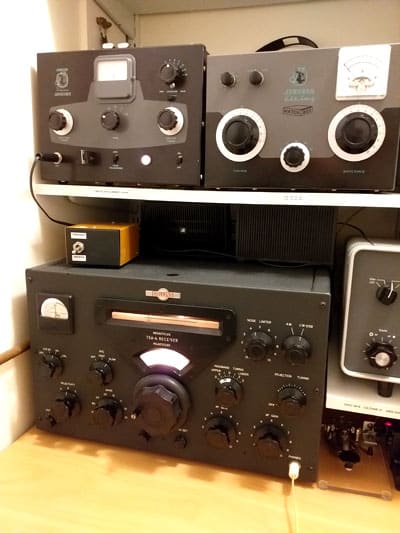 By Neil ZL1NZ
By Neil ZL1NZ
Occasionally, I like to check into the NZ Net using my mid 1950s novice station. You might have heard its cheerful chirp.
It is one of the happy truths of operating older equipment that “the more you use it, the better it works”. So, I give this old rig a run every few months – even if it’s just to keep the switch contacts clean.
The transmitter is a Johnson Viking Adventurer, containing just three valves: a rectifier, a 6AG7 oscillator and an 807 as final amplifier. It puts out around 20-25W, and I certainly don’t push it hard.
A challenge with using this transmitter on the Net is that it is crystal-controlled. But I’m still prepared in case NCS asks me to QNY for traffic. Sitting on top of the transmitter are two crystals. My “Up 5” crystal is actually “Up 2.9” and my “Down 5” crystal is actually “Down 5.2”. That’s the best I can do with my current assortment of “rocks,” although the collection is growing slowly as I find suitable crystals.
Ironically, I used to own the matching VFO for this transmitter, retained from my first ham transmitter, but I sold it many years ago, before acquiring the Adventurer. So, if you ever see a Johnson Model 122 VFO sitting on a ham shack shelf, please tell the owner I’d like to buy it back. 🙂
Getting the receiver on frequency is comparatively easy, as it provides 1kc resolution.

By the way, there is a great article about the NZ Post Office’s crystal lab, with some outstanding photos, at maritimeradio.org.
Video: TW Mag Pad
How to make a bonding wire for your key
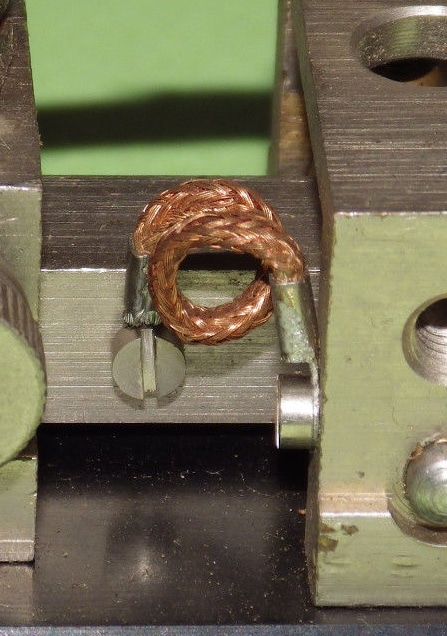 On some of my keys the bonding wire that connects the key’s lever to the frame seems to have been made with little thought – just a random bit of braid with a few twists and kinks along its route.
On some of my keys the bonding wire that connects the key’s lever to the frame seems to have been made with little thought – just a random bit of braid with a few twists and kinks along its route.
Not so on this example, made by Kees van der Spek and fitted to a WT 8 Amp No 2 key (the “ZC1 key”).
Isn’t it lovely? Superbly compact while still providing enough flexibility for the key lever to move freely.
I wonder how many attempts were required to get it just right!
Bonding wires are particularly important on Vibroplex Deluxe keys, due to their non-conductive jewel bearings.
Advertising archive

QST magazine, April 1952
Suggestions?
If you have suggestions on how to make the NZ Net better, or things you’d like to see covered in these updates, please contact ZL1NZ. You might even like to write something for the newsletter.
Thanks for reading, and I hope to hear you soon on the NZ Net!
—
Neil Sanderson ZL1NZ, Net Manager
New Zealand Net (NZ NET)
3535.0 kHz at 9pm NZT Mon-Fri




